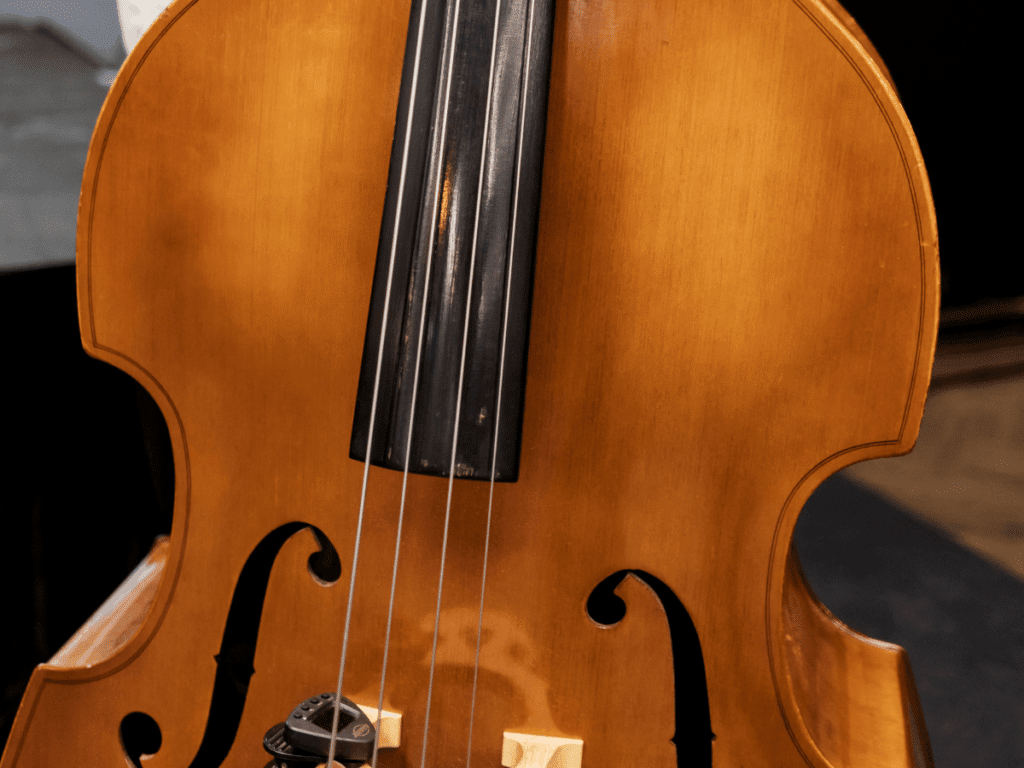Best
Portable Double Bass
-
Overall: The bass has a maple neck and an ebony fingerboard with 24 frets
-
Best Feature: Equipped with a piezo pickup system
-
TedScore™: 8/10
Best
Student Double Bass
Double Bass HIGH-QUALITY DOUBLE BASS
-
Overall: Well-regarded by musicians for its warm tone and projection
-
Best Feature: Made from aged spruce and maple
-
TedScore™: 9/10
Best
Budget Double Bass
-
Overall: Produce a range of tones that are different from an acoustic
-
Best Feature: Solid maple construction
-
TedScore™: 8/10
The double bass stands tall among instruments, dwarfing its stringed relatives with a profoundly rich sound. Ever wondered *how many strings* a double bass has?
Its size and unique shape make it a captivating instrument to behold, but it’s the number of strings that truly sets it apart.
Are you ready to discover the answer and learn more about this incredible instrument?
How Many Strings Does a Double Bass Have?
If you’re wondering how many strings a double bass has, the answer is not as straightforward as you might think. Let’s take a closer look at each of these options.
The Standard Four

The vast majority of double basses have four strings, which are typically tuned to E1, A1, D2, and G2.
These strings are usually made of either gut or steel, producing a deep, rich sound characteristic of the instrument.
Most double bass players use a bow to play the strings, although some also use their fingers or a pick.
The Uncommon Fifth

While it’s less common, some double basses have a fifth string tuned to an even lower note than the E1 string.
This is typically tuned to a low B, which allows the player to hit even lower notes than they would be able to with just four strings.
However, playing a double bass with a fifth string requires extra skill and practice, as the string is often thicker and more difficult to play than the other four.
The C Extension

Finally, some double basses have a C extension, a mechanical device that effectively extends the length of the E1 string.
This allows the player to hit even lower notes than they would be able to with just four strings without having to add a fifth string.
The C extension is typically used in classical music, where low notes are often required.
Tuning the Double Bass

When it comes to tuning the strings on a double bass, there are a few things to keep in mind.
First and foremost, the double bass is tuned in fourths, unlike other string instruments tuned in fifths.
This means that the strings are usually tuned to E1, A1, D2, and G2. Some double basses may also come with a low fifth string tuned to C below the E string.
To tune your double bass, you must use the machine heads at the top end of the neck, just below the scroll. These machine heads are used to adjust the tension of the strings, which in turn affects the pitch of the notes produced.
One popular method of tuning a double bass is to use harmonics. To do this, you must gently place your finger on the string over the harmonic point for the “5th fret and the 7th fret.”
Then, bow the string and let it ring out. While the string is still ringing, place your finger gently on the harmonic point for the following string and repeat the process.
It’s important to note that tuning a double bass can take some time and practice.
It’s also important to ensure you’re tuning your double bass to the correct pitch, as playing out of tune can be very noticeable and distracting to listeners.
Top 3 Double Basses You Can Buy

FEATURES: Solid maple construction
OTHER INFO: Volume & Bass controls
Stagg Electric Double Bass, Transparent Blue, 3/4
When you check the price above, you’ll see there are loads of great places to buy this item. Our personal favorite is Gear4music.
It is the largest music retailer in the UK and fast becoming the most respected online music shop in the US too. Their customer service is excellent, they have competitive prices, really fast shipping, and usually have the longest guarantee.
Most professional musicians use Gear4music, so there is no reason why you shouldn’t too!
- Produce a range of tones that are different from those of an acoustic double bass
- Easier to transport
- The instrument can be played at high volumes without feedback
- Expensive
The professional musician who wrote this article combined many things,
from the product build, manufacturer’s reputation through to feedback
from other users, to create our famous TedScore™.

FEATURES: Has a maple neck and an ebony fingerboard with 24 frets
OTHER INFO: equipped with a piezo pickup system
Yamaha SLB300PRO Silent Double Bass
When you check the price above, you’ll see there are loads of great places to buy this item. Our personal favorite is Gear4music.
It is the largest music retailer in the UK and fast becoming the most respected online music shop in the US too. Their customer service is excellent, they have competitive prices, really fast shipping, and usually have the longest guarantee.
Most professional musicians use Gear4music, so there is no reason why you shouldn’t too!
- It offers a warm and natural acoustic tone
- The built-in silent mode allows for practice without disturbing others
- Easy to transport the bass to gigs, rehearsals, or lessons
- Easy to adjust the tone
- Expensive
The professional musician who wrote this article combined many things,
from the product build, manufacturer’s reputation through to feedback
from other users, to create our famous TedScore™.

FEATURES: Ebony fingerboard, tailpiece, and tuning pegs
OTHER INFO: Made from aged spruce and maple
Eastman 80 Double Bass Outfit, 3/4 Size
When you check the price above, you’ll see there are loads of great places to buy this item. Our personal favorite is Gear4music.
It is the largest music retailer in the UK and fast becoming the most respected online music shop in the US too. Their customer service is excellent, they have competitive prices, really fast shipping, and usually have the longest guarantee.
Most professional musicians use Gear4music, so there is no reason why you shouldn’t too!
- Generally well-regarded by musicians for its warm tone and projection
- Aged wood may improve the sound quality over time
- Comes with a high-quality bow and padded bag for transport and storage
- It may not be the best option for beginners or students who are just starting out on the instrument
The professional musician who wrote this article combined many things,
from the product build, manufacturer’s reputation through to feedback
from other users, to create our famous TedScore™.
A Brief History of Double Bass
With its powerful and rich sound, it’s no wonder that the double bass has significantly impacted music throughout history.
In a band, the double bass provides the foundation for the rest of the music. It’s the glue that holds everything together, providing a solid and steady beat that keeps the other musicians in line.
The conductor relies on the double bass to keep the tempo and rhythm in check, ensuring the rest of the orchestra stays in sync.
The double bass has played a significant role in many different genres of music, from classical to jazz, blues, and even rock and roll.
In most rock and some jazz bands, the place of the double bass is taken by the electric bass guitar.
Its versatility and range make it a popular choice for musicians of all types, and it’s not uncommon to see a double bass player easily switching between genres.
The double bass can also produce beautiful and delicate harmonies despite its size and power.
Its ability to blend seamlessly with other instruments has made it an essential part of many orchestras and ensembles.
The Power and Influence of the Double Bass
The double bass is a remarkable instrument that is the largest and lowest-pitched bowed string instrument in the modern symphony orchestra.
Its deep, resonant tones provide a solid foundation for the rest of the ensemble, and its unique sound has made it a favourite among composers and listeners.
But did you know that its origins can be traced back to the viol, a bowed string instrument popular in the Renaissance?
The viol evolved into the bass viol in the Baroque period, eventually replaced by the double bass in the Classical era.
Ludwig van Beethoven was one of the first composers to write specifically for the double bass in his Symphony No. 5.
Another notable figure in double bass history is Serge Koussevitzky, a virtuoso player and a conductor.
He commissioned many new works for the double bass and helped to establish it as a solo instrument in its own right.
Within the realm of classical music, the double bass is often referred to as the ‘string bass. This distinguishes it from other instruments that produce lower-pitched sounds, such as brass and wind instruments. Alternatively, it may be referred to simply as ‘the bass’.
Over time, the double bass has undergone many changes and improvements, including adding a fifth string in some jazz and orchestral basses and developing new playing techniques like pizzicato and slap bass.
How Many Strings Does A Double Bass Have
Summary
The double bass is a fascinating and unique instrument that has captured the hearts of musicians and music lovers alike. Whether you’re a jazz, classical, or rock and roll fan, the deep and resonant sound of the double bass is sure to get your toes tapping and your heart racing.
A double bass normally has four thick strings tuned to E1–A1–D–G, and sometimes a fifth string is added for jazz bands to play high notes more easily, or for symphony orchestra basses, tuned to C below the E string.
And now that you know how many strings a double bass has, you can impress your friends with your newfound knowledge!
So why not pick up a double bass and start playing? You might discover a new passion and become the next great double bass player!
Before you go…
If you’re a beginner looking for the best double bass to start your musical journey, we have the perfect instrument that will have you rocking and rolling in no time!
Check out this next article to find out: Best Double Bass for Beginners
FAQ's
No, double basses typically have four strings. However, some models may have an additional fifth string for extended range.
Yes, the standard double bass has four strings, but there are also models of double bass played with a fifth string for extended range. The fifth string is usually tuned to a low C or B, allowing deeper notes to be played.
The double bass is a large, stringed instrument played with a bow or plucked with the fingers. It’s called a “double” bass because it’s the largest and lowest-pitched instrument in the string family, producing a deep, resonant sound.
The most common double bass size is 3/4, approximately 6 feet tall. However, smaller and larger sizes are also available to accommodate players of different heights and preferences.
A standard double bass typically has four strings, although some variations may have five or more strings.












While the article mentions the impact and influence of the double bass, I think it’s important to highlight the physics behind why its sound is so profoundly moving. The large surface area of its body allows for a wider range of overtones, contributing to its unique timbre, which the article fails to point out. Understanding the science behind our instruments can deeply enhance our appreciation of them.
This article brought back so many fond memories of my days teaching the double bass to eager young students. The detailed explanation of tuning and the historical context of this magnificent instrument is commendable. It’s heartening to see such educational content still being produced. Well done, Gemma Murray.
Totally agree with you there! This article’s a goldmine for teaching material.
never knew there was a bass with 5 strings. kinda makes me wanna try one out. sounds like it could add some cool depth to my tracks.
Interesting article, Gemma! Was wondering, how does the C extension on a double bass actually change the sound? Always thought all basses were the same.